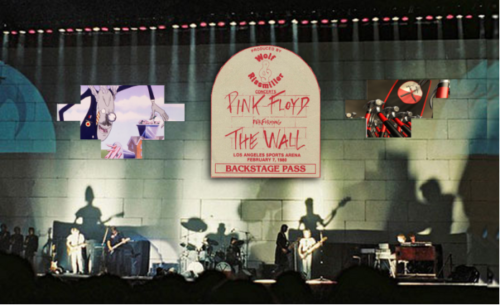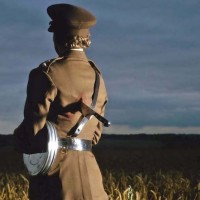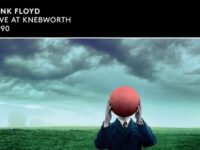
Los Angeles Memorial Sports Arena: When I was a young adult in the late 1960s, the rock music of the day had somehow permeated my psyche, and would intensify throughout the 1970s. I was fortunate to have grown up and spent a large portion of my life residing in the Los Angeles area, since all the major recording artists with a new album performed there without fail.
There were so many concerts I attended where the artist was promoting what was at the time just their latest release, but included what were to be some of the most classic albums in the rock idiom. These are tours I could have easily missed, but I had learned to seize the moment when a musical act was making a local appearance.
That realization sadly manifested after the last time Jimi Hendrix performed at the Forum in Inglewood, California. That night I was hanging out with my sister Dorothy at her apartment, which was only a couple of blocks away from the Forum; I didn’t have the money for a ticket, and rather than do whatever I could to see Hendrix I figured, “Oh well, I’ll catch him next time.” Needless to say, Hendrix passed on before any other opportunities would conveniently appear. Ugh.
Missing Hendrix for me was huge, and I after I learned of his death I vowed that I wouldn’t let it happen again. I was fortunate to go on to experience so many other iconic concerts, most of them qualifying as shows I will never forget. Anyone with even a cursory knowledge of the history of rock should be able to recognize the titles listed below, as most are closely tied to their creators. This isn’t meant to be an inventory of every tour I attended during that timeframe, but comes pretty close, including … Volunteers. Cosmo’s Factory. Idlewild South. No Dice. Who’s Next. Led Zeppelin II. Exile on Main St. Carney. Close to the Edge. The Low Spark of High Heeled Boys. Journey to the Center of the Earth. Birds of Fire. Thick as a Brick. Time Fades Away. Physical Graffiti. Larks Tongue in Aspic. Flash. Houses of the Holy. The Lamb Lies Down on Broadway. Passion Play. Before the Flood. Dark Horse. Brain Salad Surgery. Wall of Sound. Quadrophenia. Relayer. Sheer Heart Attack. 461 Ocean Boulevard. One of a Kind. Court and Spark. Diamond Dogs. Wind and Wuthering. Works, Volume 1. A Farewell to Kings. Going for the One. Terrapin Station. In the Round. Spectral Mornings.
In compiling that list, I was a bit overwhelmed to realize I was present at so many momentous shows from that era. Artists I saw numerous times through that period included Led Zeppelin (multiple times at the Forum – at one time, Zep was my main band only second to the Beatles), Yes, Genesis, the Who, Jethro Tull, and the Grateful Dead. Another show I attended during that era was Pink Floyd at the Los Angeles Memorial Sports Arena in 1975. They performed most if not all of Animals, which I assumed would be their next album. It wasn’t (that title wouldn’t come out until after Wish You Were Here) but song lyrics from both albums appeared in the comic book I got for free on that tour — or at least I seem to remember it as being free, though it might have been sold for a pittance, like for a nickel or a dime. I still have it. (Images of the comic’s content can be viewed and downloaded at various Pink Floyd fan sites, including this one.)
That was the first time I attended a Pink Floyd show, but not the last. The band would return to that same Los Angeles venue in early 1980 for a string of shows to premiere The Wall, which had been released late the previous year. The show would run for seven consecutive nights starting on February 7, 1980, with similar runs on the East Coast and in the UK. At the time, I was a member of a concert club that was created by legendary L.A. promoters Wolf & Rissmiller, where members had early access to great seats for various rock shows. (This was long before presales became a staple.)
Through the club, I was fortunate to have secured great seats for the very first performance of The Wall, to be accompanied by my longtime companion (and now my wife) Cindy, who had been with me for practically all the tours I mentioned above. (Cindy has me beat having witnessed some shows I wish I had seen: she saw the classic Yes lineup — who recorded Fragile and Close to the Edge – when they opened for Ten Years After and the J. Geils Band in San Diego — and to top it off Cindy not only has the distinction of having seen the Beatles at Dodger Stadium, she had also attended a performance by Jimi Hendrix! Even with all the shows I listed, I’m still envious.)
Shortly after I purchased The Wall tickets, a personal event occurred that appeared to jeopardize my attending those shows: I had secured a gig as guitar tech for performances by Bette Midler at the Pasadena Playhouse. These shows were to be filmed for the concert movie Divine Madness, and its rehearsals overlapped the start of The Wall performances at the Sports Arena in early February 1980. If the possibility of missing the Pink Floyd shows alone wasn’t an overall bummer, that feeling was exacerbated when I found I had inside information that the stage production for The Wall wasn’t going to be “just” another elaborate concert.
Pink Floyd was already known for their huge productions on previous tours, but these special shows would eclipse even those, boasting the most mammoth production ever mounted for rock and roll. That data surprisingly came from my best friend since high school, who was living in the Seattle area at the time. He was working for Genie Industries, which had been contracted to provide hydraulics for the shows. (For reasons I won’t go into, I will refer to this friend as Lon.) Lon was a team member for the project, and found himself first planning the logistics with Pink Floyd’s production team at Genie’s headquarters in Redmond, later traveling to L.A. to assist at the actual venue. Lon could divulge these Pink Floyd shows would blow away any other concerts I’d previously experienced, and that they would be historic events not to be missed. (Lon also disclosed that Roger Waters was very much the leader of the entire production: at the dress rehearsal, Waters would start yelling at the crew through his mic onstage over the music whenever something went wrong.)
I should mention that I had secured seats for the second Wall performance the next evening, but can’t recall if I had obtained those tickets from the concert club, or if Lon had provided them. Regardless, I was committed to my role for the Midler project and was required to be present in Pasadena whenever her band was rehearsing, which would begin early in the day and continue well into the night. I was gratified to get that gig and was resigned to the fact that I would have to miss the first performances of The Wall.
Once the Bette Midler rehearsals were in full gear, I glimpsed a ray of hope: Since my daily hours depended on the production schedule maybe, just maybe, her band (and therefore, the band crew) wouldn’t be needed for one of the two evenings, at the least. As the Pink Floyd dates approached, I found that I would be lucky beyond belief: Midler’s band wasn’t scheduled to be present for either of those first two evenings – meaning I had those nights off.
Having worked during the day of the premiere Wall show, I darted out of Pasadena at the last possible minute, racing to central L.A. to take my seat alongside Cindy, who was already there. I sat down literally a few minutes before the house lights went out for the show to begin.
On stage, there were sections of the wall partially in place on the left and right. With the house lights turned off, someone came on stage to make an announcement, only to be interrupted by the blast from the opening number (this wasn’t a mistake, as YouTube videos of other Wall performances demonstrate — and it happens both times “In the Flesh?” is performed during the show). None of the members of Pink Floyd seemed to be on stage, but I wasn’t surprised as this is a tidbit Lon had excitedly divulged to me: There were four session musicians in Pink Floyd’s place, which was referred to on the album (and apparently to the touring staff) as the “surrogate band.”
In this case, the lyrics from “In the Flesh?” took on greater depth: “Is there something eluding you, sunshine? Is this not what you expected to see?” This could be construed as referring to the fact that we see the musicians clothed in storm trooper-like outfits (including armbands adorned with the double hammers), and/or that we weren’t seeing the actual members of Pink Floyd on stage as “expected.” As the song concluded, fireworks were shot from the stage to the arena’s upper regions.
Subsequently, the actual members of Pink Floyd joined the “surrogate band” to continue the show. But suddenly Roger Waters started to scream on mic for the band to stop the music — that wasn’t part of the album, so could this be a new wrinkle added to the album’s concept? With all the surprises that were in store, a new addition to the story didn’t seem outside the realm of possibility. After the music came to a halt, Waters revealed that his announcement wasn’t planned after all: the show had to be halted and the house lights needed to be turned back on because some of the fireworks had caused something (possibly curtains) to catch on fire under the roof of the arena. Looking upward one could see something was indeed smoldering up there.
The house lights flooded the venue, and a cherry picker appeared in front of the stage. A fireman holding a fire extinguisher rode it to get close enough to the embers. When he put out the fire, the audience cheered his success just as the one hydraulic not planned for the show was lowered. Roger Waters then returned to the stage to announce that with the crisis averted the show could now (must?) go on. He indicated to the band to start where they left off, and after the house lights went out the performance continued.
That minor incident was washed away by everything that followed, which was evidence that Lon had not been exaggerating: Including the wonder of the mammoth inflatables, the scope of the production, and the tightness of the band performing new songs and extended versions of ones on the album. I was enthralled by what I was witnessing, and relieved that I was actually present. As the first half of the show progressed the stage crew started to add bricks on top of the others already in place. Eventually, the entire stage was filled with the white bricks leaving only an opening in the lower center. The process became a race against time: As I was already familiar with the entire album from start to finish, I could see that the stage crew was under the gun to get the all the bricks into place before the end of the first set.
During “Goodbye Cruel World,” it became even more obvious that the brick-building had fallen behind schedule. Towards the end of that song, there is a two-note bass figure that precedes Waters singing, “Goodbye cruel world, I’m leaving you today …” On the album, the length of time for that bass figure is pretty short, but at this show it seemed to go on forever since there was a point where the state of the wall provided a cue for Waters to start singing, and as the bass line droned on and on the crew frantically raced to complete the wall. The final word “Goodbye” was sung just as the last remaining brick was put into place into the final opening, which had been the only portion of the stage that allowed us to watch Waters perform before the intermission.
The lights came on and what stood before us seemed otherworldly. One of The Wall’s concepts touches on the figurative wall that sometimes stands between audience and performer, and here it was, now providing an actual barrier between the two. The second half of the show began with Pink Floyd heard, but not seen: “Hey You” started to be performed, and all we could see was the wall. Eventually, clever removal of certain portions of the wall was put to inventive theatrical use. Sections would open to reveal the musicians performing, images and film would be projected onto the wall at various points while Waters sang in front and, for “Nobody Home,” a living room set appeared through an opening with Roger Waters reclining in front of a working television set as he sang his lines.
(One minor item I did notice missing from the album during this song: after Waters sang “Oooh babe, when I pick up the phone,” we didn’t hear Gomer Pyle say “Surprise, surprise, surprise!” before Waters closing line, “there’s still nobody home.” Not a big deal, especially considering there were bigger priorities for challenges that were overcome on this production. But on the album, Jim Nabors uttering his TV character’s trademark line made for a poignant juxtaposition.)
A highlight was the performance of what is probably the album’s best known song, “Comfortably Numb,” with Waters in a doctor’s smock standing in front of the wall singing the doctor’s lines (“Hello, is there anybody in there?”). The audience went wild when the spotlight hit David Gilmour at the top of the wall for his part in the song. While this became a well-known highlight for both the subsequent Pink Floyd and solo Waters shows, it was startling and exciting when it happened for the first time.
The remainder of the show did not disappoint. Beginning with the reprise of “In the Flesh?,” the musicians would appear on stage in front of the wall, and would remain so for the remainder of the show, until “The Trial,” where a video was projected onto the wall — the same one used in the movie version of the album. The astonishing collapse of the wall was followed by the appearance of the musicians with acoustic instruments entering from the side of the stage to finally close this historic concert with the album’s coda “Outside the Wall” as they stood in front of the heap of bricks.
As I recall the house lights came on and the audience continued to give the show a thunderous ovation. The four members of Pink Floyd – Roger Waters, David Gilmour, Rick Wright, and Nick Mason – returned to the stage (sans instruments) to acknowledge the prolonged applause. Waters made a humorous statement, something to the effect of that there would be no encore because the stage had been demolished.
In the past decade, Roger Waters has mounted recent performances of The Wall as a solo performer. Technological advancements would provide Waters with a vastly richer and more eye-popping experience. But for me, it still wouldn’t compare to the impact of having had the opportunity to see the very first show fresh off the album’s release — coupled with the fact that, considering my circumstances, I was lucky to have been there at all. It was one of the best shows I’ve ever experienced, and one I will truly never forget.
©2017 Mike Tiano. All Rights Reserved.
- The Beatles in Seattle 1964: Internet Archive - May 8, 2024
- Steve McKnight and GayC/DC: Breaking the Rainbow Ceiling - April 22, 2024
- How the Seattle Cinerama Was Reborn as SIFF Cinema Downtown - April 12, 2024




